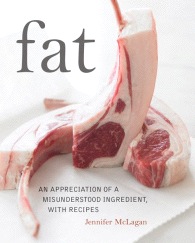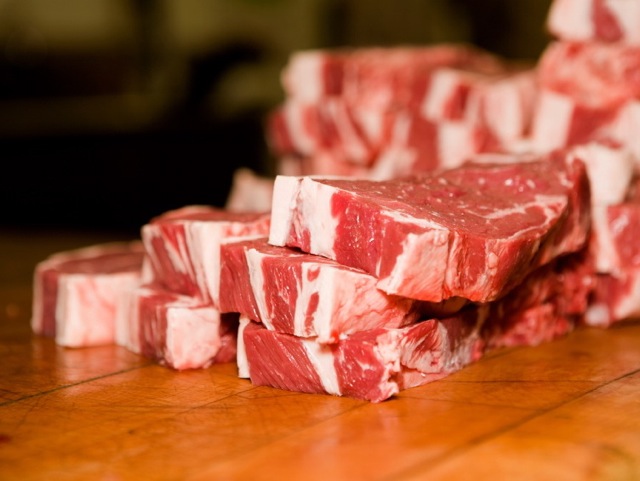
reference-image, l
(article, Jennifer McLagan)
[%pageBreakSettings nobreak=true][%adInjectionSettings noInject=true] h3. From the Introduction: "A Matter of Fat" In the 1950s, coronary heart disease emerged as a leading cause of death. Scientists searched for reasons to explain this phenomenon, and one hypothesis suggested that the increase in heart disease might be related to the cholesterol levels in our blood. [[block(sidebar). h1. About the book and author A cookbook combined with a manifesto, Fat is both a compendium of classic recipes and a call for reincorporating pure, natural animal fats in our diets. Out with the trans fats, the overly processed foods, and the belief that saturated fat is bad; in with homemade butter, potatoes fried in duck fat, and happy eaters. The book is the James Beard Foundation's 2009 Cookbook of the Year. A native of Australia, the Canada-based Jennifer McLagan specializes in books about traditional ways of eating. Excerpt reprinted with permission of Ten Speed Press (2008). ]] Soon a theory was advanced suggesting that increased consumption of animal fat raised our cholesterol levels and resulted in heart disease. The link between cholesterol, saturated fat, and heart disease was only associative, not causal, and it did not account for the fact that some populations that eat diets high in animal fats (such as the French and the Inuit eating their traditional diet) don't have high rates of heart disease. During the following two decades, science failed to prove conclusively that there was any direct connection between eating saturated fats and developing heart disease, but the theory persisted. Then, in 1977, the theory gained widespread credence when the U.S. Congress endorsed it. Americans were urged by no lesser authority than their government to reduce their fat intake for the sake of their health. Thousands of years of human history showing the importance of animal fat in our diet were overlooked, and instead it was labeled the greasy killer. While many experts still promoted a diet including eggs, meat, and animal fat, their voices were drowned out by industry and science. "Low fat" and "nonfat" became the new mantras, and since none of us wants to die any sooner than is absolutely necessary, we also obediently replaced the cholesterol-containing animal fats in our diet with new, man-made ones. The first man-made fat was margarine, created in 1869 to replace butter. Although it was cheaper than butter, it wasn't an immediate hit. At the beginning of the 20th century, lard, tallow, chicken fat, and butter were the top four fats in our kitchens. With the discovery of how to extract oil from plants and the development of the hydrogenation process, the number of industrial fats multiplied, and they became even cheaper. [%image promo-image float=right width=400 caption="Today's standard steaks have less marbling than they used to."] These new fats were slow to gain widespread popularity, but the food industry loved them. They were inexpensive and extended the shelf life of baked and fried products, so they were soon incorporated into food products and prepared foods. When animal fat came to be associated with heart disease, these new oils and spreads were marketed as a healthy alternative, and their sales took off. By the end of the 20th century, not one animal fat made the list of the most popular fats for cooking; they had all been replaced by vegetable oils. The campaign against animal fat was very successful, and it didn't stop with cooking fats. The obsession with low fat spread to our meat. We rejected marbled beef, fatty pork, and plump birds, so producers responded by breeding leaner animals. Today few of us can look at a slice of pork belly or consider a well-marbled steak without a pang of guilt or, worse, fear, even though that pork belly and steak are much leaner than they were 30 years ago. We lack the positive flavor memory that fat should trigger. This fear of fat extends to everything — especially butter. Recently scientists announced they have successfully bred a cow to give low-fat milk. Does that mean no more cream or butter? Fat was also attacked on a second front. Not just bad for our health, fat became socially unacceptable. In North America, we are surrounded by cheap, plentiful food, and since in a society of plenty anybody can get fat, being plump no longer represents wealth. [[block(sidebar). h1.Featured recipes]] "You can never be too rich or too thin," the Duchess of Windsor is quoted as saying, and being thin has become the new ideal. To be thin is to be beautiful, rich, successful, and powerful, a message reinforced daily by advertising, movies, and the fashion industry. Your weight reveals on which side of the divide you stand: rich or poor, powerful or impotent, with or without self-control. Fat has become entangled not only with health concerns but also with aesthetics, politics, and morals. Bombarded from all sides by the food industry, medical celebrities, science, the government, and the media, how could we not be convinced? The amount of animal fat in our diet has declined, and we eat less than a quarter of the butter and a fifth of the lard that we ate in 1900, and low-fat proponents claim this is why there are fewer deaths from heart disease today. However, a closer look at the data reveals that it is improved medical care that is responsible for the decline. The actual rates of heart disease haven't abated, and obesity, diabetes, and cancer rates are all on the rise. What went wrong?

reference-image, l

promo-image, l

feature-image, l

featurette-image, l

feed-image, l

newsletter-image, l